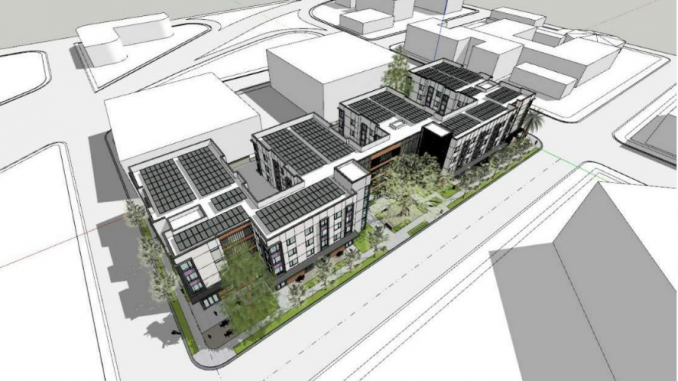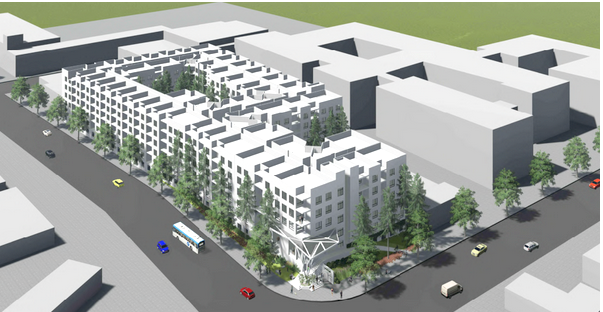
BY KYLE MARTIN
Daily Post Staff Writer
Palo Alto’s pro-housing advocates and Residentialists faced off last night (Feb. 8) to offer their opinions about two proposed housing developments that, if they’re both approved, would result in 400 new homes.
One development is a 110-unit teacher housing project at 231 Grant Ave., near the Palo Alto Courthouse, that is being championed by county Supervisor Joe Simitian. The developer is Abode Communities, a nonprofit based in Los Angeles.
The other is a 290-apartment development at 3997 Fabian Way at the corner of East Charleston Road, next to the Jewish Community Center in south Palo Alto. The developer is Chico-based Far Western Land and Investment Company, represented by Jeff Farrar.
In both cases, the council members were asked to give their opinions about the proposals. But neither project was up for approval. Instead, the developers intend to use the comments to improve the projects and bring them back to the city for approval.
At last night’s council meeting, pro-housing speakers wanted both projects to be bigger, while the Residentialists wanted them to be smaller.
Becky Sanders, co-chair of the Palo Alto Neighborhoods, a Residentialist slow-growth advocacy group, told the council said she wants the teacher housing project proposed at 231 Grant Ave., but she doesn’t want the “size and scope” of it.
Sanders said the council would be “relaxing our standards in such a gross way” if they approve the project that’s currently before the city. And she said the project’s highest peak is proposed to be built at 55-feet, which she said is too large and will likely include parts that are closer to 60-feet when the building’s heating, air conditioning and other mechanical parts are installed. The height limit in the area is 50 feet.
“We hope that we can work towards some sort of compromise where everyone gets a little bit of what they want,” Sanders told the council.
Vice Mayor Pat Burt told the council the project still fits into the city’s zoning codes and is compliant.
Kelsey Banes, executive director for Peninsula for Everyone, a Palo Alto-based pro-housing advocacy group, told the council she wants the project to be bigger.
“I do wish that we had gone for something that was maybe a little bit taller. I think seven stories would have been nice,” Banes said. “When we do things like take away density and take away height, what that really means is taking away homes for people who need them.”
And Banes said “when we’re talking about our educators, we really want to maximize the amount of housing that we get and maximize the bang for our buck.”
Raven Malone, who ran for council last year, told council the project “is the bare minimum that we can do for some of our essential workers and our teachers who work so hard and are largely underpaid.”
“We can’t keep great teachers in our school system if we’re not making it easier for them to have access to their jobs,” Malone said.
And Supervisor Simitian called into the meeting to tell the council how much he supports putting the proposed project in his former neighborhood. He said he used to live across the street from the site and said he knows the area better than most people.
The teacher housing site, Simitian told the council, will help Palo Alto retain “the best possible staff in our schools” in a time when families and teachers alike are leaving Palo Alto schools for other districts because of the cost of living in the city.
“You all know better than any one that we will never make everyone happy, and that there is a wide range of views in the community,” Simitian said. “But what we can and have to look forward to doing is engaging the whole community throughout the process so that at every opportunity, people have a chance to be heard and make their case.”

The other project before council, on Fabian Way, would take a site where offices were once located and put housing on it. That’s the city’s long range plan for many commercial sites in south Palo Alto.
The Fabian Way development would be six stories with two levels of parking and a mix of 45 studio apartments, 160 one-bedrooms and 85 two-bedrooms.
This project would also rent 10% of its units to those who make 50% area median income.
Among the speakers who opposed the project was architect Randy Popp, former head of the city’s Architectural Review Board. Popp told council the project “goes too far beyond” what the city should allow in the neighborhood.
He was joined by resident Bill Ross, who opposes the Fabian Way project and said the city doesn’t have adequate fire and paramedic services for the new residents. He pointed out that the city has reduced hours at one of its fire stations due to a funding shortage.
Mayor Tom DuBois, a Residentialist, expressed his disapproval for the Fabian Way proposal.
“I’m concerned this project is very aggressive and I think it pushes too far,” DuBois said. And he told the developer’s representative, Farrar: “You seem like an earnest person, I think you’re just asking for a little bit too much.”
He told Farrar to re-evaluate the project and come back to council later with a revised proposal.
Councilman Greer Stone said he supports the project but wants to see its 55-foot height reduced — a sentiment shared by Councilman Eric Filseth. And Vice Mayor Burt told council he wants to see a ground-floor retail space included in the project the next time it comes to council.
But Rohin Ghosh, a Palo Alto resident and Paly student, told the council he wants to see the project go up as proposed, if not scaled up more.
“I am in full support of this project. My only reservation is that I wish it were bigger,” Ghosh said. “It helps us put a dent in our jobs-to-housing imbalance, and it helps take some of that burden off our neighboring, more working class communities that really need that burden taken off of them.”


